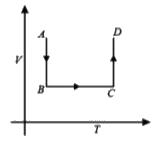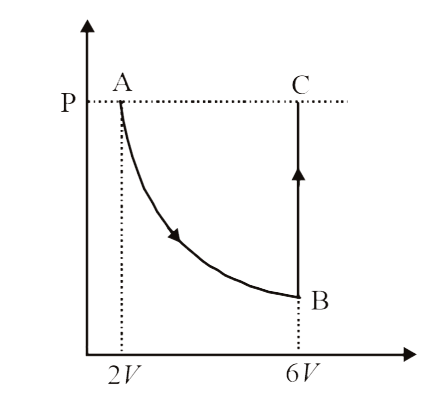One mole of a monatomic ideal gas undergoes a cyclic process as shown in the figure (where V is the volume and T is the temperature). Which of the statements below is (are) true?

Process I is an isochoric process
In process II, gas absorbs heat
In process IV, gas releases heat
Processes I and III are not isobaric
The correct Answer is:B, C, D
Process II is isothermal expansion ⇒ heat is positive
Process IV is isothermal compression ⇒ heat is negative
Similar Questions
Knowledge Check
An ideal gas undergoes the cyclic process shown in a graph below :
 AT1=T2BT1>T2CVaVc=VbVdDVaVb=VcVd
AT1=T2BT1>T2CVaVc=VbVdDVaVb=VcVdOne mole of an ideal monoatomic gas undergoes a cyclic process as shown in figure. Then the change in the energy in expanding the gas from a to c along the path abc is:
 A3P0V0B6RT0C4.5RT0D10.5RT0
A3P0V0B6RT0C4.5RT0D10.5RT0One mole of monoatomic gas undergoes a process as shown in the P-T diagram below. Choose the corresponding V – T diagram.
 A
A B
B C
C D
D

In the figure n mole of a monoatomic ideal gas undergo the process ABC as shown in the P-V diagram. The process AB is isothermal and BC is isochoric. The temperature of the gas at A is T0 total heat given to the gas during the process ABC is measured to be
Q. Temperature of the gas at C is equal to
View SolutionOne mole of an ideal monoatomic gas undergoes a cyclic process, as shown in the figure. If the temperature of the gas at state 1 is 300 K and at state 4 is 500 K, then heat exchanged during process 2→3, is

View SolutionOne mole of an ideal monoatomic gas undergoes a cyclic process, as shown in the figure. If the temperature of the gas at state 1 is 300 K and at state 4 is 500 K, then heat exchanged during process 2→3, is

View SolutionOne mole of an ideal monoatomic gas undergoes a process as shown in the figure. Find the molar specific heat of the gas in the process.

R is a gas constant.
View SolutionOne mole of a monoatomic ideal gas undergoes a thermodynamic process such thatV3T2= constant. Then,
View Solution



